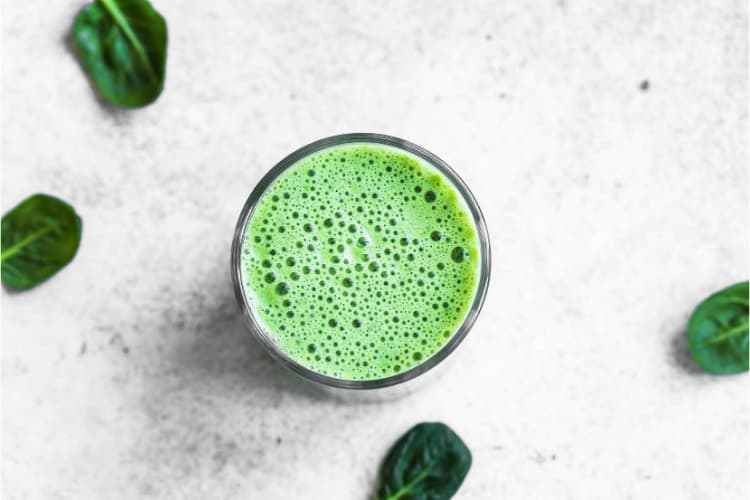
If you’re looking for a convenient way to get more nutrients into your fertility diet, then a maca fertility smoothie just might do the trick!
Maca root is indiginous to Peru and it’s officially classified as a cruciferous vegetable. In fact, it’s considered a relative of radishes (source).
Thankfully maca has a sweet and pleasant taste (in my opinion). So, there’s no risk of your smoothie tasting like radishes 🙂
Now, when it comes to fertility, maca has historically been used for men (as well as for livestock).
However, the tide is shifting as more women are becoming aware of maca’s health benefits.
So, if you happen to be one of those women and you’d like to learn more about how to use maca in a smoothie, then this post will help you understand:
- the benefits of maca for fertility.
- which type of maca to buy.
- how to use it and for how long.
- maca side effects to be aware of.
To kick things off, let’s have a look at a simple fertility-boosting maca smoothie recipe that you can make at home.
Note: this post contains affiliate links and I earn a commission (at no additional cost to you) if you use them to make a purchase.
MACA POWDER FERTILITY SMOOTHIE RECIPE
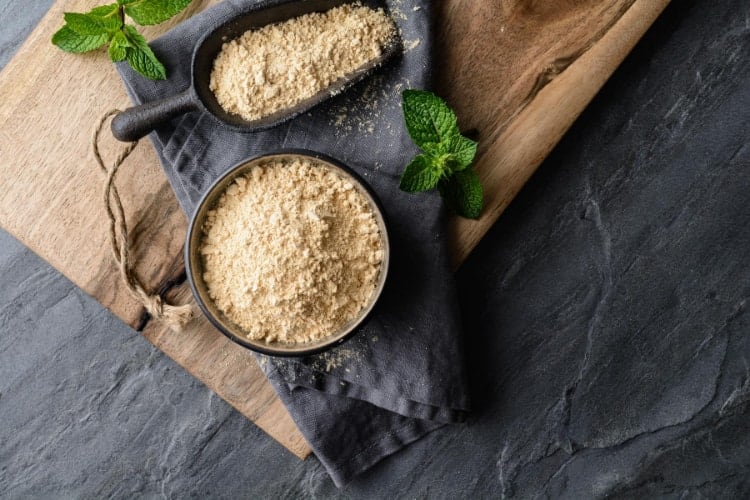
The main ingredients that I like to include in fertility smoothies are:
- bananas
- mangoes
- blueberries
- spinach
- bee pollen
- pineapple
- avocados
- hemp seeds
- limes
Below is my basic fertility smoothie. For more variations on this recipe, as well as tips on other ingredients to use, please read this article on fertility smoothies for pcos.
Basic Fertility Smoothie Recipe
1 cup mango (frozen or fresh)
1 fresh banana (diced)
1 cup baby spinach
1 tsp bee pollen
1/2 – 1 tsp gelatinized maca powder (this is the one I recommend)
3/4 cup almond milk (more if you’d like a thinner consistency)
Instructions
- Add all ingredients into a blender and blend on high until smooth.
MAIN BENEFITS OF USING MACA POWDER IN A FERTILITY SMOOTHIE
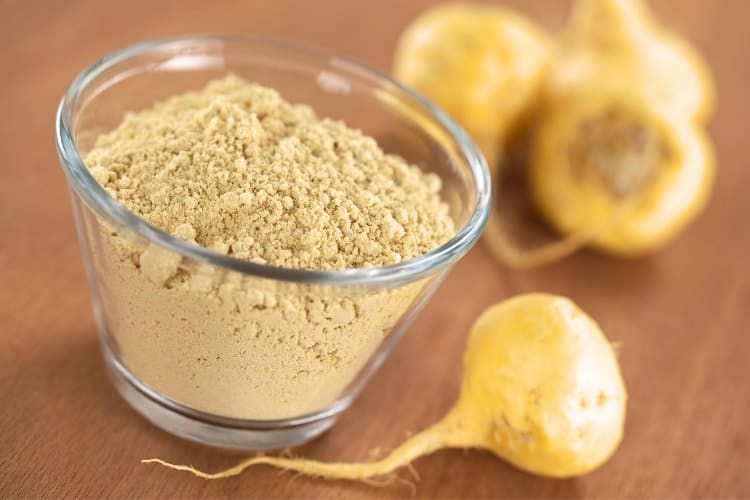
Before we dive into the specific benefits of maca root, there are a few important things to be aware of:
- there doesn’t seem to be any human studies confirming maca’s fertility benefits for women. Most of the science around this comes from animal studies (like this one) showing that maca increases litter size in mice.
- maca’s popularity as a fertility supplement for women is based mainly on anecdotal reports (source).
Despite the lack of studies performed with women, maca does have other proven benefits that provide clues as to why it’s marketed as a fertility booster
1. Has Adaptogenic Properties
Maca is an adaptogenic herb. This means that it supports our stress response system and helps the body stay in balance (source).
By the way, if you’re not familiar with the stress response system it’s also known as the HPA axis.
This HPA axis involves the hypothalamus, pituitary and adrenal glands. Each one of these glands has a direct impact on lots of hormones.
First, the hypothalamus:
- The master gland of the endocrine system.
- Releases a hormone known as GnRH (gonadotropin-releasing hormone).
Next, the pituitary gland:
- Releases luteinizing hormone (LH) and follicle stimulating hormone (FSH) in response to the GnRH that is produced by the hypothalamus.
- LH and FSH affect follicle development, ovulation and the menstrual cycle as a whole. Basically, everything related to your ability to conceive.
Last we have the adrenal glands:
- One of their main functions is to release hormones (like cortisol) that help us survive stressful situations.
All of these glands communicate with each other as well as with other parts of the body. Ultimately they work to maintain balance within the body.
However, if we’re facing a lot of stress then the HPA axis has to work harder.
And if HPA activity is elevated, that can affect the hormones that each gland produces. Ultimately, this can have a negative impact on the menstrual cycle and fertility.
In fact, here’s a quote that sums up the link between the HPA and fertility:
“While basal glucocorticoid levels are necessary for fertility and fetal survival, upregulation due to acute HPA axis activation or exogenous treatment can have detrimental effects on fertility and fetal outcomes. Elevated HPA activity is associated with altered functions of the hypothalamus, pituitary, and gonads. Moreover, the offspring of stressed mothers can present with abnormalities including reduced birth weight, higher levels of anxiety, higher levels of HPA axis function, and are at an increased risk of developing various physiological diseases.” (source – International Journal of Molecular Sciences)
Overall, this quote highlights the fact that:
- high levels of glucocorticoids (i.e. adrenal hormones like cortisol) can have a negative impact on fertility and the baby.
- an overactive HPA axis affects the hypothalamus, pituitary, and gonads.
- babies born to stressed moms could face various health issues.
So, how can maca help female fertility? Well, since maca is an adaptogen it’s effective at supporting the HPA axis.
And once the HPA has the right type of support, then it becomes easier for our hormones and other fertility-related processes to operate more smoothly.
2. May Indirectly Support Ovarian Function
Another major reason why using maca to control stress can be helpful for fertility is because:
- when there’s a lot of stress, then cortisol goes up. At the same time the liver also produces more glucose and our cells become less responsive to insulin (source).
- in this insulin resistant or high insulin state, the ovaries make more testosterone, ovulation can be inhibited and egg maturation, size or quality can all be affected (source).
So, by taking advantage of maca’s adaptogenic properties, you can regulate cortisol levels and protect your reproductive health.
NOTE: sources of stress can be chemical (food, daily toxins, viruses, bacteria, fungi), emotional or physical.
3. Provides The Nutritional Benefits of Cruciferous Vegetables
Since maca is a cruciferous vegetable, it contains some glucosinolates (as do all cruciferous veggies).
These glucosinolates are helpful for (source):
- liver detoxification.
- antioxidant production.
- metabolizing estrogen (glucosinolates are broken down in the body and this produces indole-3-carbinol, which is a compound that helps metabolize estrogen)
This last piece is quite significant because healthy estrogen levels are one of the essential ingredients for natural fertility.
Too much or too little estrogen affects ovulation and the menstrual cycle (source).
WHICH COLOR AND TYPE OF MACA TO USE IN A FERTILITY SMOOTHIE
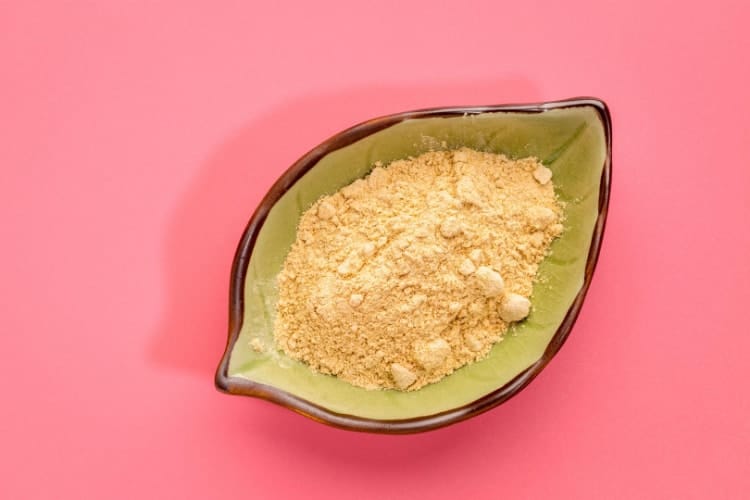
There are two main things to look out for when buying maca: the color and the type (raw or gelatinized).
Red vs. Yellow vs. Black Maca Powder for Fertility
There are 3 main colors of maca: red, yellow and black.
These color differences pertain to the skin of the root and the chemical composition of the root. The inside of the root pretty much maintains the same tan color.
Overall, the general suggestion is to use:
- red maca for female fertility.
- black maca for male fertility (it increases sperm count and motility in mice – 3, 4 )
- yellow maca for general health and general endocrine support.
Raw vs. Gelatinized Maca for Natural Fertility
Maca powder is sold in two forms: raw or gelatinized
Here’s what you need to know about raw maca powder.
- the maca root is dried and ground into a powder.
- most of the nutrients are preserved because the drying process occurs at a low temperature.
- it contains a lot of maca’s natural starch. Unfortunately, that starch is also harder on the digestive system.
Now, here’s the deal with gelatinized maca:
- there’s no actual gelatin in it! The maca roots are simply boiled and then pressurized to remove most of the starch. This produces what is generally called “gelatinized maca.”
- it’s easier to digest since there’s not much starch left.
- some nutrients (such as enzymes and vitamin C) are degraded during the cooking process.
- on the flip side, the cooking process activates other minerals and metabolites that provide significant health benefits.
So, how do you decide which maca to use? Here are some tips:
- If your gut is healthy and you don’t have digestive issues, feel free to use raw maca.
- However, if you tend to have GI issues or you struggle to digest cruciferous veggies, then reach for gelatinized maca.
To get started you can try this gelatinized red maca powder. It’s made by The Maca Team a family-run company that specializes exclusively in quality maca products sourced from Peru.
HOW MUCH MACA TO USE IN A FERTILITY-BOOSTING SMOOTHIE
So far the research done on maca has used various doses, ranging from 2000 mg all the way up to 9mg.
As a result, there’s no one dosage that is deemed “perfect” for a fertility-boosting smoothie.
However, to get the health benefits of maca, some experts recommend taking anywhere from 2,000 to 3,500 mg per day (source).
This is a lower dose that is generally safe for most people. If necessary, you can gradually increase the dose as your body adapts to the herb.
NOTE: 1 tsp of maca is equivalent to 3000mg.
HOW LONG DOES IT TAKE TO SEE RESULTS FROM A FERTILITY SMOOTHIE WITH MACA?
How long it takes to see results from maca varies from one person to another and the symptoms.
For example, this study showed that maca improves sexual dysfunction in women within 12 weeks. In another study (referenced earlier in this article) maca improved male fertility after 4 months.
So, plan on drinking your fertility smoothie for a couple of months before you start looking for visible improvements.
Also, do keep in mind that like all adaptogens, maca is not intended for long-term use.
Here are some general guidelines to be aware of when using this herb or any other adaptogen (source):
- Take one day off each week.
- After six weeks of use, take a week off.
- If you’ve already been using maca for 6 months, take a month off.
RELATED QUESTIONS
Does Maca contain caffeine?
Although maca is known to increase energy, it doesn’t contain caffeine. Instead, maca’s energy boosting properties come mainly from its ability to support the adrenals and endocrine system as a whole.
You basically end up feeling more energetic because your body is working more efficiently.
Does Maca have side effects?
Since maca is a cruciferous vegetable, it can have a goitrogenic effect on some people. This means in some people maca could interfere with the thyroid’s ability to absorb and use iodine.
So, if you’re not getting sufficient iodine in your diet, then be mindful of using maca.
In addition, some people also report feeling jittery when they take maca (source). It’s not clear what this is due to, so monitor how your body reacts to this herb.
Lastly, there are concerns that maca extracts can have an estrogenic effect.
So, it would be best to avoid them if you have any estrogen-dependent conditions (source). Please note that this estrogenic effect is related to extracts from maca, not the whole root itself.
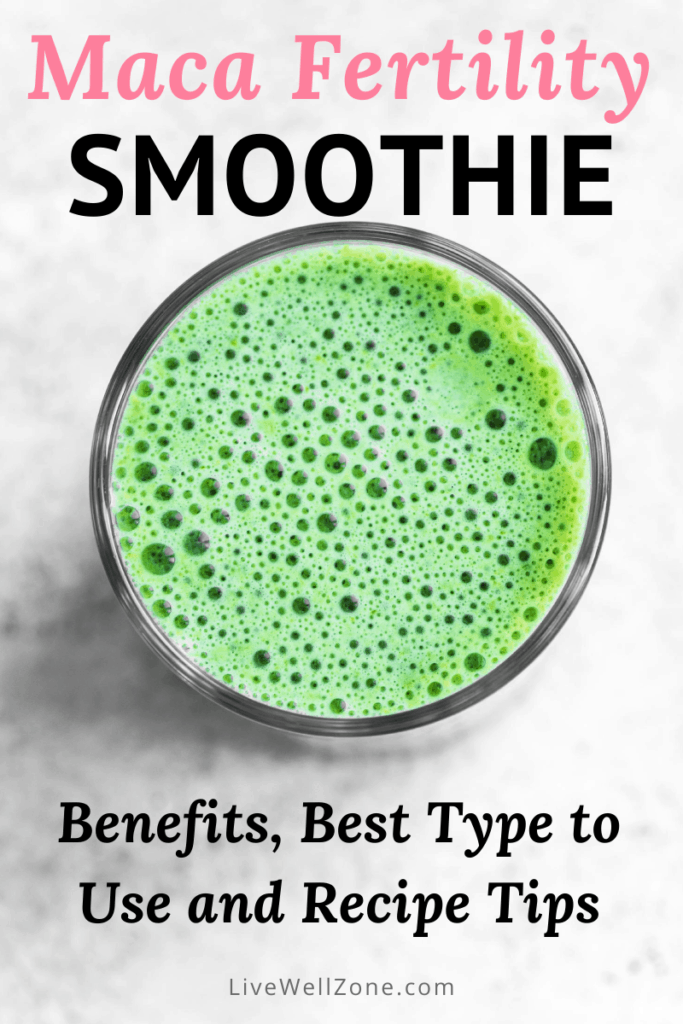
CONCLUSION
Even though the scientific community doesn’t yet have a full understanding of maca, its historical use as fertility remedy has made it a popular supplement.
I hope this post answered your question about maca powder and how to use it in a fertility smoothie.
If you have any questions or feedback, feel free to drop a comment below.
You Might Also Like:
A Complete Guide to Choosing the Best Maca for Female Fertility
Smoothies For Hormone Balance: Top Tips & Recipes To Use Today
5 Things You Should Know Before Using Black Cohosh for PCOS And Fertility
5 Natural Alternatives to Clomid
Fertility Diet To Improve Egg Quality Naturally: A Complete Guide with Food List
How to Use Maca for Hormone Balance: A Complete Guide for Beginners
Best Maca Supplement For Menopause


